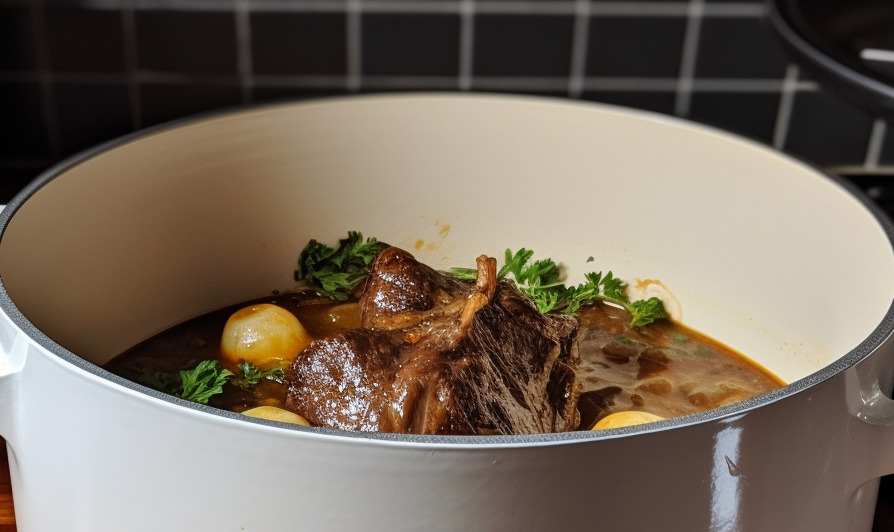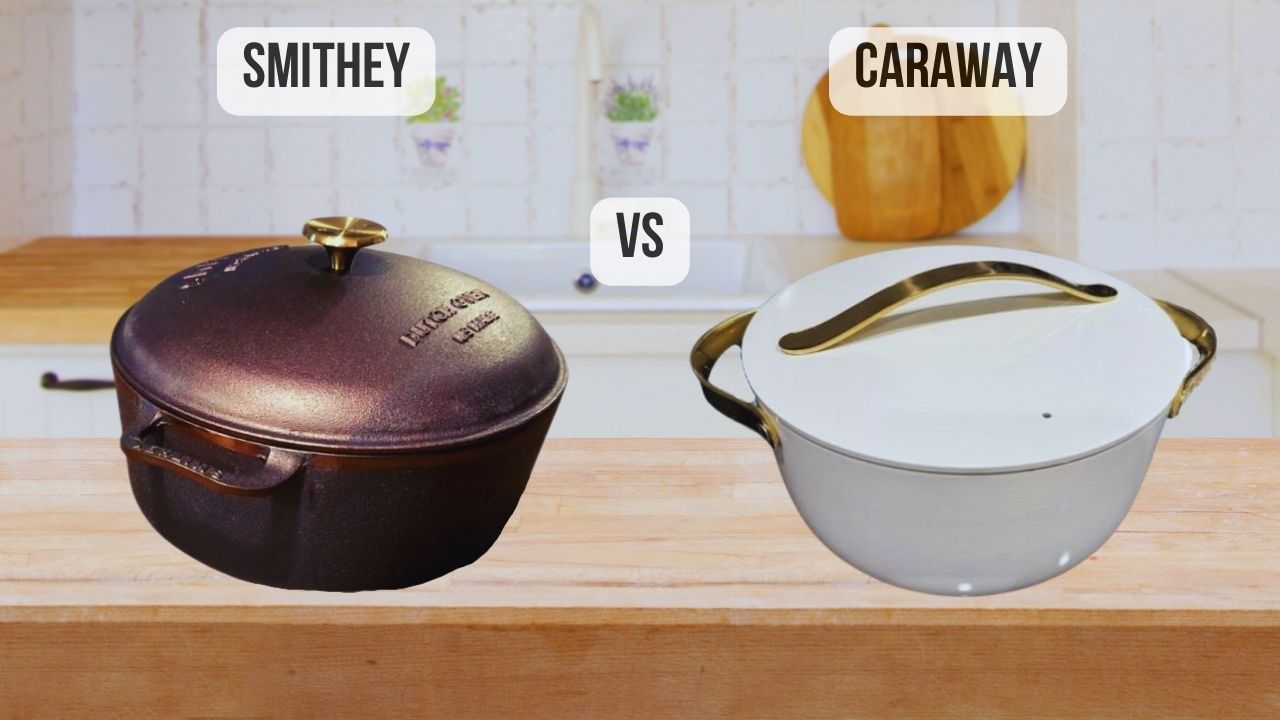As a seasoned restaurant chef with a decade of experience, I’ve encountered various kitchen tools, particularly Dutch ovens. In my latest exploration, I turn my focus to two renowned brands: Smithey and Caraway. These names are synonymous with high-quality cookware, and their Dutch ovens are no exception.
This article presents a detailed comparison of the Dutch ovens from Smithey and Caraway. We’ll delve into key aspects that are crucial when choosing the right Dutch oven for your culinary needs. These aspects include:
- Material
- Weight
- Heat retention and compatibility
- Lid fit
- Handles and product design
- Colors
- Maintenance and cleaning
- Durability and performance
- Warranty
- Price
The Smithey Dutch Oven is a culinary masterpiece crafted with meticulous attention to detail. This Dutch oven is one of my favorites, as I am captivated by its sturdiness, premium materials, and timeless design.
The Caraway Dutch oven offers a modern and chic version of the traditional Dutch oven. Its sleek and contemporary appearance piqued my interest, so I bought one to test it.
These two Dutch ovens have solidified their positions in the TOP-5 best Dutch ovens available today.
By examining these features, we aim to provide a comprehensive overview, helping you decide which Dutch oven best suits your kitchen. Let’s start by exploring each of these Dutch ovens individually before comparing them side by side to see which one comes out on top.
In this review, I provide an independent assessment of the pros and cons of Smithey and Caraway, based on my experience as a chef. If you choose to purchase it, please consider using the referral links included in this article. I earn a small commission from your purchases at no additional cost to you, which helps support this blog. Thank you!
Smithey VS Caraway: Material
| Smithey | Caraway |
|---|---|
| Smithey Dutch Ovens are crafted from high-quality cast iron. They are hand-finished with a polished interior and a matte enameled exterior, giving them a sleek and premium appearance. | Caraway Dutch Ovens are made from lightweight cast aluminum with a non-toxic ceramic nonstick layer. |
Smithey VS Caraway: Weight
| Smithey | Caraway |
|---|---|
| Because of its high-quality construction, Smithey Dutch Ovens are known for their heft. While the material used proves its durability, it can be a drawback for some people who are not used to heavy cookware. | Caraway Dutch Ovens are significantly lighter than their cast iron counterparts, making them more manageable for everyday cooking. |
Smithey VS Caraway: Heat Retention and Compatibility
| Smithey | Caraway |
|---|---|
| The Smithey Dutch Oven excels in heat retention, making it ideal for precise temperature control during cooking. Its cast iron body retains heat exceptionally well, which is crucial for recipes like braised short ribs, where a steady simmer is needed to tenderize the meat and enhance flavors. The Dutch oven’s compatibility with various heat sources, including stovetops, ovens, and open flames, allows for a seamless transition from searing to slow braising. | While Caraway Dutch Ovens perform well in heat retention, they may not hold heat as long as cast iron. They are compatible with various heat sources, including stovetops and ovens. |
Smithey VS Caraway: Lid Fit
| Smithey | Caraway |
|---|---|
| The Smithey Dutch Oven comes with a well-fitting lid that helps to trap moisture and heat effectively, ensuring your dishes come out perfectly cooked. It has self-basting spikes under the lid to ensure even moisture and flavor distribution, improving the taste and texture of dishes. | The Caraway Dutch Oven‘s tightly fitting lid traps moisture and preserves the flavor of the dishes I prepare. |
Smithey VS Caraway: Handles and Product Design
| Smithey | Caraway |
|---|---|
| The handles of the Dutch oven are thoughtfully crafted, offering a comfortable hold and effortless control. The handles’ ergonomic design makes it easy to lift and maneuver even when carrying a heavy pot filled with food. The Dutch oven’s elegant appearance combines classic allure with modern sophistication. Smithey Dutch ovens truly serve as authentic, eye-catching centerpieces in any kitchen. | Caraway Dutch Ovens feature ergonomic stainless steel handles that stay cool on the stovetop. Their design is modern and sleek, fitting well in contemporary kitchens. |
Smithey VS Caraway: Colors
| Smithey | Caraway |
|---|---|
| Smithey offers a limited color range. It has an enameled exterior, typically featuring a classic black finish. | Caraway offers a limited but attractive color selection to match various kitchen aesthetics. |
Smithey VS Caraway: Maintenance and Cleaning
| Smithey | Caraway |
|---|---|
| While cast iron requires a tad more maintenance than nonstick alternatives, the Smithey Dutch Oven‘s smooth interior enamel makes cleaning a relatively straightforward task. I only need to soak it briefly and scrub it gently with a non-abrasive sponge to remove cooking residues. It’s essential to ensure thorough drying and apply a light oil coating to prevent rust to maintain its optimal condition. | It’s easy to maintain and clean the Caraway Dutch Oven. Even after lengthy cooking sessions, the nonstick ceramic coating makes cleaning up easy and helps avoid food sticking. It is also dishwasher safe, so you can save time cleaning it. |
Smithey VS Caraway: Durability and Performance
| Smithey | Caraway |
|---|---|
| Smithey undeniably upholds its dedication to durability, meticulously crafting this Dutch oven with top-tier materials. The Dutch oven’s remarkable performance makes it a wise long-term investment. By giving proper care and maintenance, this Dutch oven can endure for many years and become a cherished heirloom passed down to the next generation. | While Caraway Dutch Ovens may not match the lifelong durability of cast iron, they offer excellent performance and can serve you well for many years if maintained properly. |
Smithey VS Caraway: Warranty
| Smithey | Caraway |
|---|---|
| Smithey offers a limited lifetime warranty on their Dutch Ovens. This warranty reflects the company’s confidence in the product’s durability. | Caraway provides a one-year warranty, still offers confidence in the product’s quality. |
Smithey VS Caraway: Price
| Smithey | Caraway |
|---|---|
| Smithey Dutch Ovens are on the higher end of the price spectrum, justifying the investment with premium materials and craftsmanship. | Compared to Smithey, Caraway Dutch Ovens are more reasonably priced. Its price point makes it a desirable choice for people seeking quality without going over budget. |
Cooking Test

During our cooking test, we cooked Red Wine Braised Short Ribs in both the Smithey and Caraway Dutch Ovens. This test provided an opportunity to evaluate the performance of each Dutch oven in three critical areas: browning, moisture retention, and the final flavor of the dish.
Browning

Getting the meat to sear perfectly is the first step in making delicious Red Wine Braised Short Ribs. The Smithey Dutch Oven‘s remarkable heat retention produced a flawless sear.
Smithey made the ribs brown evenly and thoroughly, improving the dish’s overall look and flavor. The result was a visually beautiful and scrumptious base for braising.
On the other hand, the Caraway has produced a beautiful sear on the ribs, enhancing the overall flavor and texture of the final dish.
Moisture Retention
Both Dutch ovens exhibited impressive moisture retention capabilities during the lengthy braising process. The Smithey Dutch Oven is renowned for its ability to maintain a consistent simmer. It ensured that the short ribs remained juicy and tender. The braising liquid clung to the meat, resulting in a perfectly moist final dish.
Final Flavor

Both the Smithey and Caraway Dutch Ovens contributed to an extraordinary culinary experience. In the Smithey Dutch Oven, precise temperature control allowed the flavors to meld harmoniously. The short ribs developed a remarkable depth of flavor, their taste rich and satisfying.
How We Tested
To conduct a fair cooking test, I prepared Red Wine Braised Short Ribs in both the Smithey and Caraway Dutch Ovens, using the same cooking methods for each to maintain neutrality.
My first step was to assess their browning capabilities, observing their effectiveness in achieving the ideal sear on the meat. Next, I examined their ability to retain moisture, a vital factor for a dish that demands extended braising. Finally, I evaluated the intensity and richness of the flavors in the finished dishes.
Our approach to testing was thorough and uniform, ensuring an accurate comparison of the Smithey and Caraway Dutch Ovens in these essential parameters.
Conclusion: Smithey is The Winner
In concluding this comprehensive comparison between the Smithey and Caraway Dutch Ovens, my experience and detailed testing have led me to a clear winner: the Smithey Dutch Oven.
This conclusion is drawn from a meticulous analysis of various aspects, including material, weight, heat retention, lid fit, handle design, color options, maintenance requirements, durability, warranty, and price. In each of these areas, the Smithey Dutch Oven consistently demonstrated superior qualities that set it apart from its Caraway counterpart.
The cooking test with Red Wine Braised Short Ribs was particularly revealing. The Smithey Dutch Oven excelled in producing an evenly browned sear on the meat, a crucial step in this dish. Its exceptional heat retention capabilities not only facilitated a perfect sear but also maintained a consistent simmer throughout the cooking process. This resulted in meat that was both tender and juicy, with flavors that were rich and deeply satisfying.
While the Caraway Dutch Oven also performed admirably, offering a sleek design and effective functionality, it fell slightly short in comparison to the robust performance and enduring craftsmanship of the Smithey.
However, if you are looking for an affordable Dutch oven for home cooking, then, Smithey might be a good option for you. If you decide to purchase it, please use my referral link.

